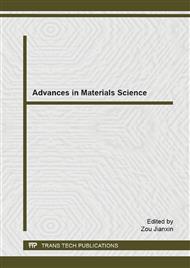[1]
Saleh M.H., Priestner R. Retained austenite in dual-phase silicon steels and its effect on mechanical properties[J]. Journal of Materials Processing Technology, 2001, 113(1-3): 587-593.
DOI: 10.1016/s0924-0136(01)00638-0
Google Scholar
[2]
Erdogan M., Tekeli S. The effect of martensite particle size on tensile fracture of surface carburized AISI 8620 steel with dual phase core microstructure [J]. Materials and Design, 2002, 23(7): 597-604.
DOI: 10.1016/s0261-3069(02)00065-1
Google Scholar
[3]
Mousavi S.H., Vahdani H. Room-Temperature mechanical properties of dual-phase steels deformed at high temperatures [J]. Materials Letters, 2005, 59(14-15): 1828-1830.
DOI: 10.1016/j.matlet.2004.08.046
Google Scholar
[4]
C. Roucoules P.D. Hodgson,S. Yue, et al. Softening and microstructural change following thedynamic recrystallization of austenite[J]. Metallurgical and Materials transactions A. 1994, 25(2):389-400.
DOI: 10.1007/bf02647984
Google Scholar
[5]
C. Roucoules,M. Pietrzyk P.D. Hodgson. Analysis of work hardening and recrystallization during the hot working of steel using a statistically based internal variable model[J]. MaterialsScience and Engineering A. 2003, 339(1–2): 1-9.
DOI: 10.1016/s0921-5093(02)00120-x
Google Scholar
[6]
Dipti Samantaray, Sumantra Mandal A.K. Bhaduri. A comparative study on Johnson Cook, modified Zerilli–Armstrong and Arrhenius-type constitutive models to predict elevated temperature flow behaviour in modified 9Cr–1Mo steel[J]. Computational Materials Science, 2009, 47: 568-576.
DOI: 10.1016/j.commatsci.2009.09.025
Google Scholar
[7]
Amit Kumar Gupta V.K. Anirudh, Swadesh Kumar Singh. Constitutive models to predict flow stress in Austenitic Stainless Steel 316 at elevated temperatures[J]. Materials and Design, 2013, 43:410-418.
DOI: 10.1016/j.matdes.2012.07.008
Google Scholar
[8]
Y.C. Lin, Xiao-Min Chen. A combined Johnson–Cook and Zerilli–Armstrong model for hot compressedtypical high-strength alloy steel[J]. Computational Materials Science, 2010, 49: 628-633.
DOI: 10.1016/j.commatsci.2010.06.004
Google Scholar
[9]
Qingyu Hou, Jing Tao Wang. A modified Johnson–Cook constitutive model for Mg–Gd–Y alloy extended to a wide range of temperatures[J]. Computational Materials Science, 2010, 50: 147-152.
DOI: 10.1016/j.commatsci.2010.07.018
Google Scholar
[10]
Y.C. Lin, Xiao-Min Chen, Ge Liu. A modified Johnson–Cook model for tensile behaviors of typical high-strength alloy steel[J]. Materials Science and Engineering A, 2010, 527: 6980-6986.
DOI: 10.1016/j.msea.2010.07.061
Google Scholar
[11]
Dipti Samantaray, Sumantra Mandal, Utpal Borah A.K. Bhaduri P.V. Sivaprasad. A thermo-viscoplastic constitutive model to predict elevated-temperature flow behaviour in a titanium-modified austenitic stainless steel[J]. Materials Science and Engineering A, 2009, 526: 1-6.
DOI: 10.1016/j.msea.2009.08.009
Google Scholar
[12]
Dipti Samantaray, Alpesh Patel, Utpal Borah S.K. Albert A.K. Bhaduri. Constitutive flow behavior of IFAC-1 austenitic stainless steel depicting strain saturation over a wide range of strain rates and temperatures[J]. Materials and Design, 2014, 56: 565-571.
DOI: 10.1016/j.matdes.2013.11.053
Google Scholar


